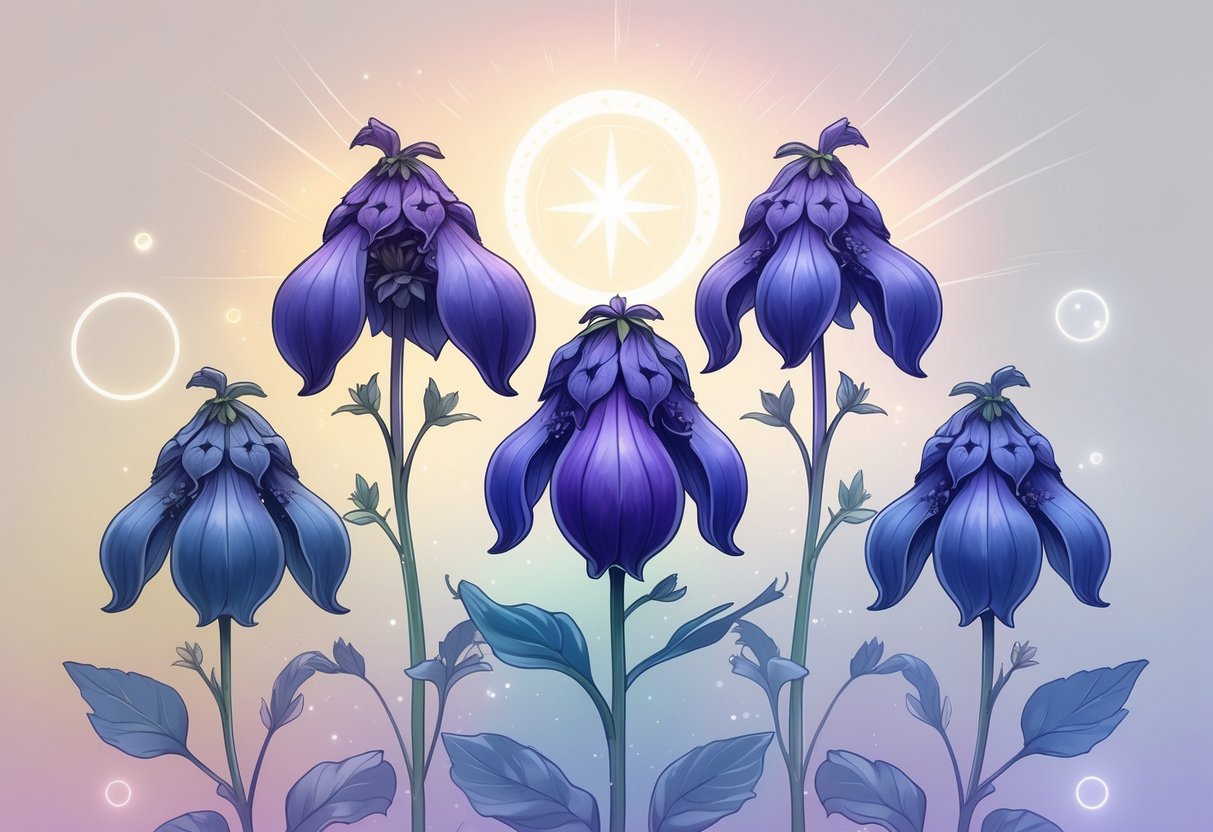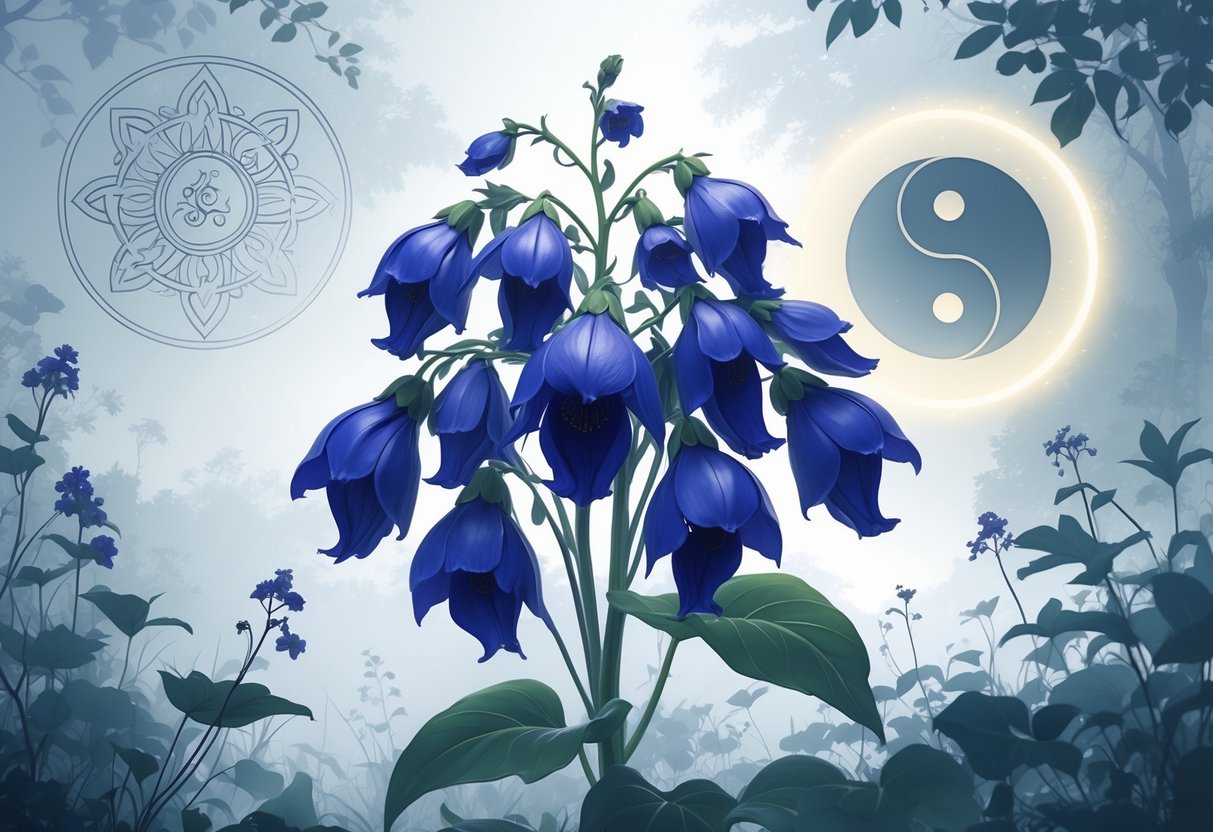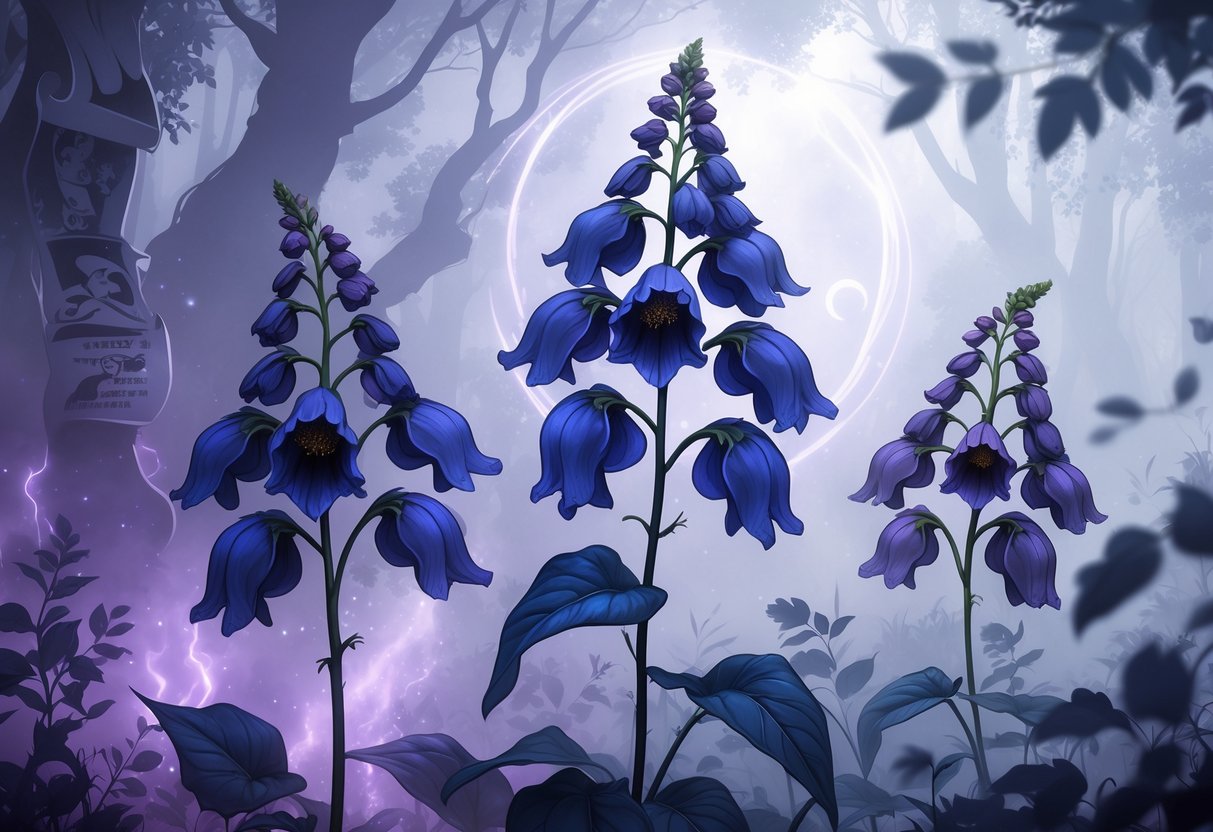Monkshood is a flower known for its striking appearance and deep spiritual meaning across many cultures. It symbolizes themes such as transformation, protection, healing, and spiritual growth, making it a powerful symbol in both ancient and modern spiritual practices. Its unique shape and rich history give it a special place in stories, dreams, and rituals.

Beyond its beauty, the monkshood flower carries a message of caution due to its toxicity, which adds to its symbolism of danger and mystery. It has been used in spiritual traditions to represent trustworthiness and purity but also to warn against hidden threats. This complex blend of meanings makes monkshood a fascinating subject for anyone interested in the deeper side of flowers and their spiritual significance.
Key Takeaways
- Monkshood represents transformation and spiritual growth.
- It holds a dual meaning of protection and caution.
- Its symbolism is rooted in rich cultural and historical contexts.
What Is the Monkshood Flower?

The Monkshood flower is known for its striking appearance and strong symbolism. It has a long history tied to both beauty and danger. Understanding its origins, common names, and safety concerns helps provide a full picture of this unique plant.
Origins and Botanical Background
Monkshood, scientifically called Aconitum napellus, belongs to the buttercup family. It is a perennial plant that grows in mountainous regions of Europe and parts of Asia. The plant can reach about 3 feet (1 meter) tall.
Its leaves are dark green and palmate, meaning they spread out like fingers on a hand. The flowers grow in clusters on spikes and usually appear in shades of deep purple or blue, though some varieties have white, pink, or yellow flowers.
The flower’s hooded shape is unique and resembles a monk’s hood, which is where the name Monkshood comes from. This shape helps distinguish it from other flowers in gardens and the wild.
Common Names and Varieties
Monkshood is also known by other names such as Wolfsbane and Aconite. These names often relate to its ancient uses and folklore. Wolfsbane refers to its rumored power to repel wolves and other threats in old legends.
There are several varieties of Monkshood, differing mainly in flower color and size. Most common are the blue and purple types, but gardeners may also find white and yellow ones. Each type carries the same basic shape and toxic properties.
Besides garden varieties, the wild Monkshood grows naturally in cool, high-altitude areas. These natural types tend to be more potent in their chemical makeup than cultivated ones.
Toxicity and Safety Considerations
Monkshood contains a deadly toxin called aconitine. This poison affects the heart and nervous system and can cause serious harm or death if ingested. Handling the plant with bare hands can sometimes cause skin irritation or numbness due to the toxin.
Because of its toxicity, Monkshood should never be eaten or used in homemade remedies. Only trained medical professionals should use it under strict supervision in traditional medicine.
In gardens, it is important to keep Monkshood out of reach of children and pets. Wearing gloves when touching or cutting the plant is also strongly advised to avoid accidental poisoning.
The 6 Spiritual Meanings of the Monkshood Flower

The monkshood flower holds several deep spiritual meanings tied to its appearance, history, and effects. These meanings reflect its dual nature as both a symbol of warning and a tool for growth. Many cultures view the plant as a source of power and change.
Danger and Protection
Monkshood, also known as aconitum or wolfsbane, is highly toxic. This toxicity has made it a symbol of danger in many traditions. The plant warns of hidden threats and encourages caution.
At the same time, monkshood is believed to offer protection. It is used in magical practices to ward off evil spirits and negative energies. Its powerful presence acts as a shield for those who handle it carefully.
The flower’s dark and striking appearance adds to this meaning. It reminds people to respect nature’s forces and stay alert to risks around them.
Transformation and Metamorphosis
Monkshood is connected to ideas of change and rebirth. In literature and myth, consuming or encountering the plant often signals a personal transformation.
This flower symbolizes the ability to overcome challenges and emerge stronger. It represents facing fears and navigating difficult transitions.
Monkshood’s role in this process reflects its complex nature. It can cause harm or healing, depending on how it is used. This duality makes it a powerful symbol of growth and new beginnings.
Spiritual Awareness and Intuition
The monkshood flower is linked to spiritual growth and intuition. Its purple-blue colors relate to higher consciousness and inner awareness.
In some spiritual practices, the flower is used during meditation to deepen connection with one’s intuition. It encourages the seeker to explore emotional depths and subconscious thoughts.
Monkshood’s strong tie to water elements emphasizes sensitivity and psychic ability. Drawing near to this flower can inspire greater trust in inner guidance and emotional clarity.
Symbolism of Monkshood in Different Cultures

Monkshood holds a rich symbolic presence across various cultures. It is linked to powerful figures, spiritual concepts, and protective meanings. Its dual nature as both beautiful and dangerous shapes its role in myths, traditions, and folklore.
Greek and Roman Mythology
In Greek mythology, Monkshood is closely connected with Hecate, the goddess of magic and the underworld. She is often shown with this flower, symbolizing mystery, transformation, and the supernatural. The flower’s toxic nature aligns with Hecate’s power over life and death.
The Romans linked Monkshood with Pluto, god of the underworld, reinforcing its association with death and the afterlife. The plant was believed to have connections to Cerberus, the three-headed dog guarding the underworld’s gates, symbolizing protection and warning.
Its presence in these myths highlights themes of danger and spiritual power. The flower’s dark, hood-like petals evoke secrecy and the unseen forces of the spirit world.
Buddhist and Eastern Traditions
In Buddhism and some Eastern cultures, Monkshood carries a different meaning. It symbolizes spiritual growth, purity, and higher consciousness. The flower’s deep purple color is seen as a symbol of spiritual awakening and wisdom.
Monkshood is used in meditation and rituals to help focus and deepen spiritual insight. Despite its poisonous qualities, it is valued for its symbolic connection to healing and protection on a spiritual level.
In traditional Chinese medicine, the plant has been used cautiously for pain relief and inflammation, showing a respect for its power. It embodies the balance between harm and healing in these traditions.
European Folklore
In European folklore, Monkshood, also called Wolfsbane, is linked to magic, protection, and danger. It was believed to ward off evil spirits, witches, and werewolves. Its toxic properties made it a symbol of caution and defense.
Witches were said to use Monkshood in potions and spells, enhancing its reputation as a magical and dangerous plant. The flower often represented fatal attraction and hidden threats in stories and superstitions.
At the same time, it symbolized transformation and rebirth. The plant’s deadly nature was seen as a metaphor for change, warning people to be careful but also to recognize the power of transformation in life.
Monkshood in Legends, Folklore, and Art

Monkshood has a strong presence in myths and artistic works, often linked with supernatural powers and danger. It appears frequently in stories about witches, mythical creatures, and spiritual guardians. Its image is used to symbolize protection, transformation, and hidden knowledge.
Magical and Occult Associations
Monkshood is closely tied to magic and the occult. It is often connected to Hecate, the goddess of witchcraft and the night, who is sometimes shown with Cerberus, the three-headed dog guarding the underworld. The plant is believed to have protective energy, used to ward off evil spirits and negative forces.
In magic, monkshood is used in rituals for invisibility and banishing harmful influences. The roots and leaves are burned in ceremonies to cleanse spaces. However, handling it requires care due to its strong poison. Legends say it protects against werewolves, a fearsome symbol in folklore that monkshood’s other name, wolfsbane, references.
Depictions in Literature and Fine Art
Monkshood’s dark reputation has made it a popular symbol in literature and art. Writers often use it to represent danger, mystery, or death. It appears in stories involving poison or betrayal because of its lethal properties.
In paintings and illustrations, monkshood is shown with its deep blue or purple hood-shaped flowers, often emphasizing its eerie beauty. It’s linked to gothic themes and supernatural tales, highlighting both its allure and threat. This dual nature has inspired many authors and artists to include monkshood in their works to convey hidden power or deadly intent.
Spiritual Uses and Interpretations in Modern Life
The Monkshood flower holds a strong place in spiritual practice today, valued for its protective and transformative symbolism. Its use spans personal growth and ritual work, linking ancient meanings to current spiritual needs.
Monkshood Flower as a Spiritual Symbol Today
Monkshood is often seen as a symbol of protection and inner strength in modern spirituality. It represents the ability to face challenges with courage and adapt to change. People use the flower’s image or essence to create a sense of safety and resilience.
Its connection to transformation means it can inspire personal growth. Monkshood’s dark, hooded petals are linked to mystery and the unseen, adding depth to its symbolism. In spiritual art and decor, it often appears to remind individuals of the balance between beauty and danger.
The flower’s toxic nature also reinforces its role as a warning and boundary marker. This aspect helps people set limits and foster a clear mental space, guarding against harmful influences.
Monkshood in Meditation and Rituals
Monkshood is sometimes used in meditation to encourage focus on protection and change. Practitioners may visualize the flower or incorporate its colors to enhance mental strength. Its imagery aids in overcoming fears and facing inner challenges during quiet reflection.
In rituals, Monkshood symbolizes warding off negative energy. It may be included in protective spells or ceremonies aimed at clearing harmful influences. Because the flower has historic ties to mystical power, it adds seriousness and intention to spiritual work.
Handling Monkshood requires caution due to its toxic nature, so many use symbolic representations rather than the physical plant. This maintains safety while keeping its spiritual power present in ceremonies or personal practice.
Growing Monkshood for Spiritual and Decorative Purposes

Monkshood, also called wolfsbane, is grown both for its striking look and its spiritual significance. It requires careful planting and ongoing care to thrive and maintain its protective qualities in a garden setting.
Garden Uses and Protective Planting
Monkshood is often planted as a natural barrier because of its toxic nature, which helps keep pests and animals away. Its tall, hooded flowers add a mysterious, elegant touch to garden beds and borders. Many gardeners use monkshood near entrances or pathways, believing it offers protection from negative energy.
The plant is popular in spiritual gardens, where it symbolizes strength and defense. Planted among herbs used for healing or cleansing rituals, monkshood enhances the garden’s energizing effect. Care must be taken to keep it out of reach of children and pets due to its high toxicity.
Cultivation and Care Recommendations
Monkshood thrives best in moist, well-draining soil with partial shade to full sun. It prefers cooler climates and does well in mountain or temperate regions. Water regularly, ensuring soil stays damp but not soggy, to prevent root rot.
This plant benefits from balanced fertilizer applied in early spring. It is important to wear gloves when handling wolfsbane as all parts of the plant are poisonous. Deadheading spent flowers encourages a longer blooming period and prevents accidental seed spread in unwanted areas.
Regular monitoring for pests and diseases helps maintain plant health. Monkshood does not tolerate dry or very hot conditions, so protection during extreme weather is advised to preserve its appearance and spiritual vigor.
Follow us on Social Media!
I’m Nina, and I’m very passionate about spirituality. Exploring the depths of the soul and connecting with the divine has always been my source of inspiration. Join me on a journey of self-discovery and inner peace through my writing.
